Related Research Articles

Sea urchins are spiny, globular echinoderms in the class Echinoidea. About 950 species of sea urchin live on the seabed of every ocean and inhabit every depth zone — from the intertidal seashore down to 5,000 meters. The spherical, hard shells (tests) of sea urchins are round and spiny, ranging in diameter from 3 to 10 cm. Sea urchins move slowly, crawling with tube feet, and also propel themselves with their spines. Although algae are the primary diet, sea urchins also eat slow-moving (sessile) animals. Predators that eat sea urchins include a wide variety of fish, starfish, crabs, marine mammals. Sea urchins are also used as food especially in Japan.

Mosasaurs comprise a group of extinct, large marine reptiles from the Late Cretaceous. Their first fossil remains were discovered in a limestone quarry at Maastricht on the Meuse in 1764. They belong to the order Squamata, which includes lizards and snakes.
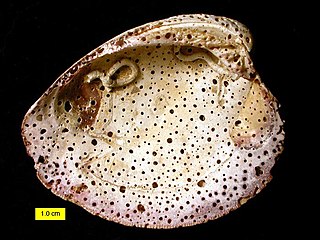
Bioerosion describes the breakdown of hard ocean substrates – and less often terrestrial substrates – by living organisms. Marine bioerosion can be caused by mollusks, polychaete worms, phoronids, sponges, crustaceans, echinoids, and fish; it can occur on coastlines, on coral reefs, and on ships; its mechanisms include biotic boring, drilling, rasping, and scraping. On dry land, bioerosion is typically performed by pioneer plants or plant-like organisms such as lichen, and mostly chemical or mechanical in nature.
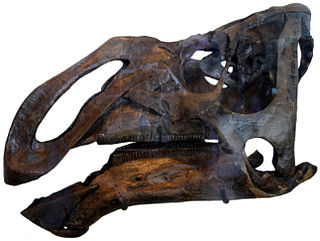
Kritosaurus is an incompletely known genus of hadrosaurid (duck-billed) dinosaur. It lived about 74.5-66 million years ago, in the Late Cretaceous of North America. The name means "separated lizard", but is often mistranslated as "noble lizard" in reference to the presumed "Roman nose".
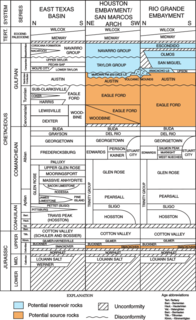
The Glen Rose Formation is a shallow marine to shoreline geological formation from the lower Cretaceous period exposed over a large area from South Central to North Central Texas. The formation is most widely known for the dinosaur footprints and trackways found in the Dinosaur Valley State Park near the town of Glen Rose, Texas, southwest of Fort Worth and at other localities in Central Texas.
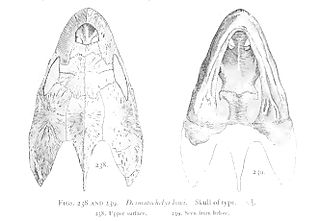
Desmatochelys is an extinct genus of sea turtles belonging to the family Protostegidae. This genus contains two known species, D. lowii and D. padillai. D. lowii was first discovered in 1895, followed by D. padillai in 2015. Having been estimated at over 120 million years old, D. padillai is currently the oldest known species of sea turtle.

Eucidaris tribuloides, the slate pencil urchin, is a species of cidaroid sea urchins that inhabits littoral regions of the Atlantic Ocean. As a member of the basal echinoid order Cidaroida, its morphological, developmental and molecular genetic characteristics make it a phylogenetically interesting species.

The Echinothurioida are an order of sea urchins in the class Echinoidea. Echinothurioids are distinguished from other sea urchins by the combination of a flexible test and hollow spines. The membrane around the mouth contains only simple plates, in contrast to the more complex mouth parts of their close relatives, the Diadematoida. They are nearly all deepsea dwellers.
Skeletogenesis is a key morphogenetic event in the embryonic development of vertebrates and is of equal, although transient, importance in the development of the sea urchin, a marine invertebrate. The larval sea urchin does not resemble its adult form, because the sea urchin is an indirect developer, meaning its larva form must undergo metamorphosis to form the juvenile adult. Here, the focus is on skeletogenesis in the sea urchin species Strongylocentrotus purpuratus, as this species has been most thoroughly studied and characterized.

During most of the Late Cretaceous the eastern half of North America formed Appalachia, an island land mass separated from Laramidia to the west by the Western Interior Seaway. This seaway had split North America into two massive landmasses due to a multitude of factors such as tectonism and sea-level fluctuations for nearly 40 million years. The seaway eventually expanded, divided across the Dakotas, and by the end of the Cretaceous, it retreated towards the Gulf of Mexico and the Hudson Bay. This left the island masses joined in the continent of North America as the Rocky Mountains rose. From the Cenomanian to the end of the Campanian ages of the Late Cretaceous, Appalachia was separated from the rest of North America. As the Western Interior Seaway retreated in the Maastrichtian, Laramidia and Appalachia eventually connected. Because of this, its fauna was isolated, and developed very differently from the tyrannosaur, ceratopsian, hadrosaurid, pachycephalosaur and ankylosaurid dominated fauna of the western part of North America, known as "Laramidia".
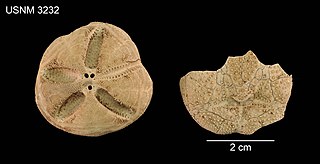
Abatus cordatus is a species of sea urchin in the family Schizasteridae. It is native to shallow seas surrounding certain island groups in the southern Indian Ocean. The body is protected by a hard test or shell which is covered with spines. The female broods its young in deep pockets on the upper surface, retaining the young in place with specialised spines. American zoologist Addison Emery Verrill first scientifically described A. cordatus in 1876.

Paleontology in Texas refers to paleontological research occurring within or conducted by people from the U.S. state of Texas. Author Marian Murray has remarked that "Texas is as big for fossils as it is for everything else." Some of the most important fossil finds in United States history have come from Texas. Fossils can be found throughout most of the state. The fossil record of Texas spans almost the entire geologic column from Precambrian to Pleistocene. Shark teeth are probably the state's most common fossil. During the early Paleozoic era Texas was covered by a sea that would later be home to creatures like brachiopods, cephalopods, graptolites, and trilobites. Little is known about the state's Devonian and early Carboniferous life. However, evidence indicates that during the late Carboniferous the state was home to marine life, land plants and early reptiles. During the Permian, the seas largely shrank away, but nevertheless coral reefs formed in the state. The rest of Texas was a coastal plain inhabited by early relatives of mammals like Dimetrodon and Edaphosaurus. During the Triassic, a great river system formed in the state that was inhabited by crocodile-like phytosaurs. Little is known about Jurassic Texas, but there are fossil aquatic invertebrates of this age like ammonites in the state. During the Early Cretaceous local large sauropods and theropods left a great abundance of footprints. Later in the Cretaceous, the state was covered by the Western Interior Seaway and home to creatures like mosasaurs, plesiosaurs, and few icthyosaurs. Early Cenozoic Texas still contained areas covered in seawater where invertebrates and sharks lived. On land the state would come to be home to creatures like glyptodonts, mammoths, mastodons, saber-toothed cats, giant ground sloths, titanotheres, uintatheres, and dire wolves. Archaeological evidence suggests that local Native Americans knew about local fossils. Formally trained scientists were already investigating the state's fossils by the late 1800s. In 1938, a major dinosaur footprint find occurred near Glen Rose. Pleurocoelus was the Texas state dinosaur from 1997 to 2009, when it was replaced by Paluxysaurus jonesi after the Texan fossils once referred to the former species were reclassified to a new genus.
The prehistory of the United States comprises the occurrences within regions now part of the United States during the interval of time spanning from the formation of the Earth to the documentation of local history in written form. At the start of the Paleozoic era, what is now "North" America was actually in the southern hemisphere. Marine life flourished in the country's many seas, although terrestrial life had not yet evolved. During the latter part of the Paleozoic, seas were largely replaced by swamps home to amphibians and early reptiles. When the continents had assembled into Pangaea drier conditions prevailed. The evolutionary precursors to mammals dominated the country until a mass extinction event ended their reign.
Calveriosoma gracile is a species of sea urchin in the order Echinothurioida. It is a deep water species and is found on the seabed in western parts of the Pacific Ocean at depths of 200 to 800 metres.
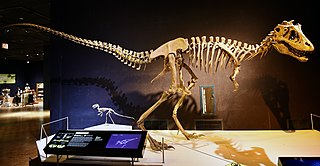
Lythronax is a genus of tyrannosaurid dinosaur that lived in North America around 81.9-81.5 million years ago during the Late Cretaceous period. The only known specimen was discovered in Utah in the Wahweap Formation of the Grand Staircase–Escalante National Monument in 2009, and it consists of a partial skull and skeleton. In 2013, it became the basis of the new genus and species Lythronax argestes; the generic name Lythronax means "gore king", and the specific name argestes originates from the Greek poet Homer's name for the wind from the southwest, in reference to the specimen's geographic provenance in North America.

The Echinothuriidae are a family of sea urchins in the order Echinothurioida. Due to their soft skeletons, most are called "leather urchins", but species in the genus Asthenosoma are also known as "fire urchins" due to their bright colors and painful, venomous sting.

Asterocidaris is a genus of fossils sea urchins in the family Hemicidaridae. These epifaunal grazer-deposit feeders lived in the Middle and Upper Jurassic age.
Tetragramma is a genus of fossil sea urchins known from the Upper Jurassic (Oxfordian) to the Upper Cretaceous (Turonian).

Echinoid fossils are the fossilised remains of sea urchins, spiny marine invertebrates that live on the seabed. Humans have been interested in these fossils for millennia, have considered them lucky, have imbued them with magical powers and linked them to their deities.
References
- 1 2 Thompson Jr., William R. (November 2016). Fossil Echinoids of Texas: A Monograph of Fossil Sea Urchins. River Stix. ISBN 978-1617042782.
- ↑ "Tetragramma donaldtrumpi Thompson, 2016". ZooBank . Retrieved 3 January 2019.
- 1 2 Wheeler, Christine DeLong (7 November 2016). "New species of fossil sea urchin named after Donald Trump". WMUR. Retrieved 17 February 2017.
- ↑ "Tetragramma Agassiz, 1838". The Echinoid Directory. Natural History Museum, London. Retrieved 2017-01-24.
- ↑ Mendoza, Madalyn (7 November 2016). "With fossil, Donald Trump becomes 'permanent part of the scientific record'". San Antonio Express-News. Retrieved 17 February 2017.